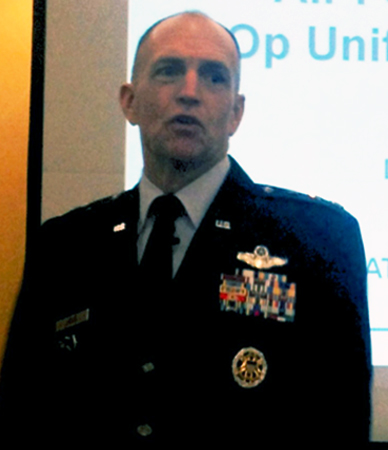After virtually exhausting their inventory of precision-guided munitions in the 2011 Libya operation, most NATO European allies are building their stocks back up, said Lt. Gen. Ralph Jodice, NATO Allied Air Component commander at Izmir, Turkey, on Tuesday. “I think the large majority probably has” rebuilt its stocks of PGMs since Operation Unified Protector, said Jodice at an AFA-sponsored Air Force Breakfast Program address in Arlington, Va. NATO partners each contribute “unique enablers” to the alliance, he said. In addition to aerial tanking and intelligence, surveillance, and reconnaissance, US “capacity” to build PGMs should be considered among these unique enablers, said Jodice during his Feb. 12 talk. While Britain, France, and a few others can manufacture their own PGMs, the United States makes the majority of such weapons for the alliance, and “I believe one of its responsibilities for [the Libya] operation was to provide precision-guided munitions,” he said. Jodice noted that orders from the North Atlantic Council mandated that there be no collateral damage or civilian casualties during OUP, so it was necessary that “100 percent—every weapon we dropped—was a PGM.” He said he doesn’t think it’s realistic to expect smaller NATO nations “to have months and months” of stockpiles. (See also Lessons from Libya from Air Force Magazine’s 2011 archive.)
virtually exhausting their inventory of precision-guided munitions in the 2011 Libya operation, most NATO European allies are building their stocks back up, said Lt. Gen. Ralph Jodice, NATO Allied Air Component commander at Izmir, Turkey, on Tuesday. “I think the large majority probably has” rebuilt its stocks of PGMs since Operation Unified Protector, said Jodice at an AFA-sponsored Air Force Breakfast Program address in Arlington, Va. NATO partners each contribute “unique enablers” to the alliance, he said. In addition to aerial tanking and intelligence, surveillance, and reconnaissance, US “capacity” to build PGMs should be considered among these unique enablers, said Jodice during his Feb. 12 talk. While Britain, France, and a few others can manufacture their own PGMs, the United States makes the majority of such weapons for the alliance, and “I believe one of its responsibilities for [the Libya] operation was to provide precision-guided munitions,” he said. Jodice noted that orders from the North Atlantic Council mandated that there be no collateral damage or civilian casualties during OUP, so it was necessary that “100 percent—every weapon we dropped—was a PGM.” He said he doesn’t think it’s realistic to expect smaller NATO nations “to have months and months” of stockpiles. (See also Lessons from Libya from Air Force Magazine’s 2011 archive.)
House, Senate Unveil Competing Proposals for 2026 Budget
July 11, 2025
Lawmakers from the House and Senate laid out competing versions of the annual defense policy bill on July 11, with vastly different potential outcomes for some of the Air Force’s most embattled programs.